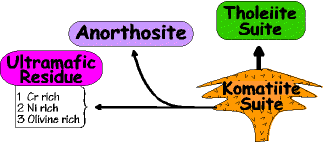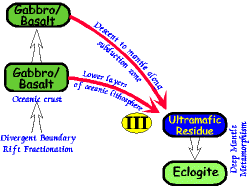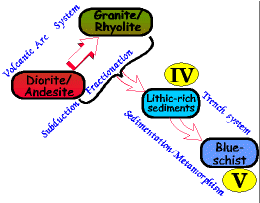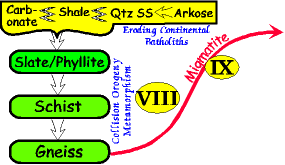 Descriptions of Processes Operating At Each Stage in the Tectonic Rock Cycle
 I - Generation of mafic oceanic crust
by fractional melting of ultramafic parent magma at an oceanic divergent plate boundary (rift zone). Stage C and Stage D of Wilson cycle, or at any divergent plate boundary generating ophiolite suite.
I - Generation of mafic oceanic crust
by fractional melting of ultramafic parent magma at an oceanic divergent plate boundary (rift zone). Stage C and Stage D of Wilson cycle, or at any divergent plate boundary generating ophiolite suite.Tectonically, this step begins where the earth's tectonic processes begin, with a mantle convection cell rising toward the surface bringing ultramafic parent magma with it. The Wilson cycle assumes a rifting continent, but rift initiation need not involve a continental mass. Intraoceanic rifting events are possible. The tectonic rock cycle assumes an unspecified intraoceanic rifting of undefined origin. Lithologically, the ultramafic parent magma fractionally melts as it approaches the surface creating a mafic melt which forms the oceanic crust (ophiolite layers 2 and 3), leaving behind in the mantle an ultramafic residue (ophiolite layer 4). Although most rocks in the tectonic rock cycle are straight forward, the ultramafics present possible confusion since they appear more than once, in different guises. The first ultramafic is designated the parent. It is the compositionally rich magma which fractionates at rift zones. The second ultramafic in the tectonic rock cycle is the sterile fractionated residue generated by fractionation of ophiolite layers 1 and 2 at the subduction zone. In the ARCHAEAN, the earliest and oldest phase of earth history, the mafic parent was called the komatiite suite, and it generated an oceanic lithosphere quite different from that generated today.  II - Generation of intermediate/felsic igneous rocks by fractional melting
in a subduction zone to form diorites/andesites (IIA of the tectonic rock cycle) and eventually granites (most likely plagiogranites)/rhyolites (IIB of the tectonic rock cycle). These will form in either Stage E of the Wilson cycle, or Stage G or any comparable stage where there is a subduction zone.
II - Generation of intermediate/felsic igneous rocks by fractional melting
in a subduction zone to form diorites/andesites (IIA of the tectonic rock cycle) and eventually granites (most likely plagiogranites)/rhyolites (IIB of the tectonic rock cycle). These will form in either Stage E of the Wilson cycle, or Stage G or any comparable stage where there is a subduction zone.Tectonically, this phase of the tectonic rock cycle has shifted from a divergent plate boundary where oceanic lithosphere is generated to a convergent plate boundary where oceanic lithosphere is destroyed. Subduction zones may form either intraoceanically (Wilson Stage E), or along continental edges (cordilleran type; Wilson Stage G). Because cordilleran orogenies have igneous and metamorphic processes similar to volcanic arcs, and because most cordilleran orogenies end in a collision orogeny, which is a later part of the tectonic rock cycle, they are not explicitly discussed here. Lithologically, the (ophiolite suite) descending in the subduction zone begins cold. As it descends it gradually heats because of the geothermal gradient and friction of subduction. But the descending slab also carries a lot of sea water with it and at about 120 km down the water and heat lead to fractional melting of the mantle material just above the subducting slab. As heating progresses only the lower temperature phases (lower on Bowen's Reaction Series) in the rock melt to produce magmas of intermediate composition. And since these are fluid and hot they rise up through the crust to eventually emplace and solidify as intermediate rocks (e.g. diorites, granodiorites, etc). The second fraction is the unmelted residue with a composition more mafic/ultramafic than the original rock. That is, its composition is higher in Bowen's Reaction Series than the original rock. The initial melt may be mafic (tholeiitic suite) (the reason Gabbro/Basalt appears at both Steps I and IIA), but evolves through time (and space) to intermediate (diorite/andesite) and felsic (plagiogranite/rhyolite) rocks. Magma rising toward the surface creates a volcanic arc. Emplacement of batholiths creates new continental crust. The tectonic rock cycle does not say that all the intermediate and felsic igneous rocks are derived from the same parent in one continuous fractionation sequence any more than Bowen's reaction series says all the igneous rocks must crystallize from the same cooling magma, starting at the top. The tectonic rock cycle illustrates the general flow of fractionation events, not the specific conditions and circumstances of the events. It is quite likely, however, that the intermediate batholiths emplaced early in the volcanic arc cycle may be themselves fractionally melted by heat released from later rising magmas to produce the alkaligranites and related rocks. This could easily occur in a protocontinent situation. If a subduction zone is active long enough a considerable mass of intermediate and felsic batholiths (calcalkaline and alkaline suites) can accumulate. If there are enough batholiths they can form a protocontinent, the small nuclear core of what could become a large continent through repeated Wilson cycles occurring along its margins. In the Archaean, the earliest stage in the earth's history, all the continents began as volcanic arcs that either collided together to form small protocontinental blocks, or as volcanic arcs that were active long enough to create large enough masses of batholiths to become protocontinents (cross section series).  III - Generation of high P/high T ecolgite by descent of unmelted oceanic lithosphere
(ultramafic residue) into mantle along subducting plate, accompanied by high P/high T (eclogite) metamorphism. Stage E (and in more complicated tectonic rock cycles, Stage G) of the Wilson cycle.
III - Generation of high P/high T ecolgite by descent of unmelted oceanic lithosphere
(ultramafic residue) into mantle along subducting plate, accompanied by high P/high T (eclogite) metamorphism. Stage E (and in more complicated tectonic rock cycles, Stage G) of the Wilson cycle.Tectonically, a process coupled with the fractional melting taking place above the subduction zone (Step II). As the oceanic slab descends and fractionally melts, the unmelted ultramafic residue remains in the mantle or continues to descend with the subducting oceanic lithosphere. Lithologically, the oceanic lithosphere continuing to descend into the mantle has now been fractionated twice, once at the oceanic rift center, and now a second time along the subduction zone. It is a sterile residue (as opposed to a parent) ultramafic rock. There is nothing more to fractionate from it. At the high temperatures and pressures inside the mantle it metamorphoses to eclogite, the first metamorphic rock in the tectonic rock cycle.  IV - Generation of lithic rich sediments by weathering of a volcanic arc.
Stage E of the Wilson cycle.
IV - Generation of lithic rich sediments by weathering of a volcanic arc.
Stage E of the Wilson cycle.Tectonically, an outcome of the continuing process of subduction in Steps II and III. Lithologically, once the volcanoes rise above the sea surface active weathering begins. Because mostly volcanic rocks are weathering the sediments are lithic-rich. On deeper weathering, down into coarser igneous rocks (or shallower porphorys) feldspars may be added (follow red arrows on QFL diagram). If plagiogranites or granodiorites are present more or less amounts of quartz will be present. The result is lithic-rich to feldspar-rich sediments deposited in submarine fans surrounding the volcanic arc, the first sedimentary rocks of the tectonic rock cycle.  V - Generation of high P/low T Blueschist melange along a subduction zone.
Stage E (and in more complicated tectonic rock cycles, F) of the Wilson cycle.
V - Generation of high P/low T Blueschist melange along a subduction zone.
Stage E (and in more complicated tectonic rock cycles, F) of the Wilson cycle.Tectonically, a continuing process of the subduction zone in Steps II, III and IV. Sediment weathering from the volcano pours into the trench where it is scraped off and upward to form the melange belt of the outer arc ridge. Lithologically, on the backarc side the lithic sediment enters geologic dormancy for some unspecified time. On the forearc side the sediment enters a trench. Some sediment is scraped off and thrust upward forming an outer arc ridge. The remainder of the sediment is subducted. Because the sediment goes down quickly along the subduction zone, pressure on the sediment rises rapidly while temperature rises slowly; blueschist metamorphism.  VIa - Generation of arkosic sediments on a Micro(proto)- continent.
VIa - Generation of arkosic sediments on a Micro(proto)- continent. Arkose is the second sedimentary rock generated in the tectonic rock cycle (the first were the lithic rich sediments of stage IV.) Arkose is in the tan field of the QFL. Stage VIa does not simply or directly mirror a stage in the Wilson cycle. Arkosic sediments are generated any time feldspar-rich continental basement rock (felsic igneous) is uplifted and exposed to weathering. The closest Wilson cycle stage is the rifting of Stage B, but this implies a continent already exists. But what about the generation of the first arkosic sediments? They would have appeared relatively early in the earth's history, in the Archaean. But they would have required the generation of protocontinents from volcanic arc processes, and then microcontinents from them through cordilleran orogenies (Wilson, Stage G) or continental collisions (developmental series). Tectonically, in an evolutionary tectonic rock cycle, Step VIa is formation of a proto(micro)continent. If an intraoceanic subduction zone is active long enough, a large volume of intermediate and felsic batholithic rocks are emplaced forming a low density plug in the lithosphere (detail). At the end of the volcanic cycle, active mountain building ceases and erosion removes the volcanoes. Eventually the batholiths are exposed and eroded to a peneplain, leaving them floating isostatically as a micro(proto)continent just above sea level. Lithologically, in Step VIa the weathering and eroding sediments are evolving through a sequence of maturation. At stage IV sediments are lithic-rich, but as intermediate and felsic batholiths are exposed in Step VI feldspar-rich Arkosic sediments result (QFL; follow red arrows). Arkose is the second of the major QFL sedimentary rocks to appear in the model. In Step VII they complete their weathering sequence.  VIb - Generation of quartz/- lithic/feldspar sediments from a major mountain building.
VIb - Generation of quartz/- lithic/feldspar sediments from a major mountain building. Tectonically, Step VIb is a collision style orogeny (Wilson Stage F, or Wilson H), or a cordilleran orogeny ( Stage G). Subduction zones create remnant ocean basins, which will eventually close shut causing a collision between arcs, or arcs and continents, or continents and continents. The collision style orogenies build large thrust belt mountains in the hinterland, and foreland basins in the foreland. Such collisions bring mountain building cycles to an end since the remnant ocean is closed by these events. Lithologically, in Step VIb the thrust belt mountain contains a great diversity of rocks, including volcanic, sedimentary, metamorphic, and uplifted intermediate and felsic basement which form the core of the continents. As these weather and erode a mixed quartz/feldspar/lithic sediment results (QFL, blue field). These sediments are characteristically quartz rich (>50%) because the sedimentary rocks weathering from the hinterland have already been through at least one cycle of weathering and thus have a high quartz content. As long as the mountain remains high and weathering is rapid and incomplete the sediments remain immature to submature. As the mountain erodes, however, these sediments evolve through a sequence of maturation, completed in Step VII.  VII - Generation of quartz/shale/limestone on a peneplaned (micro/proto)continent.
VII - Generation of quartz/shale/limestone on a peneplaned (micro/proto)continent. Tectonically, the (micro/proto)continent is stable, weathered and eroded to a peneplain. Such a situation shows up three times in the Wilson cycle: Stage A, Stage G (west side), and Stage I. Stable continental blocks are not that common on the earth today; we seem to be in a time of intense geological activity across most of the earth. However, western Australia and central North America (the plains) are examples. Even these do not appear as stable as times in the past when very mature quartz sandstones were deposited across wide areas. Lithologically, the arkose from Step VIa, OR the quartz/lithic/feldspar sediment from Step VIb are completely weathered. The feldspars and lithics have gone to shale and dissolved salts. The carbonate salts precipitate out either chemically or biochemically forming limestone and dolomite. The quartz remains as an unweathered residue. With mature quartz sand we have the last of the fields on the tectonic QFL diagram. With quartz sand, shale, and carbonate we have the final end-member products, the three attractors, of weathering/sorting/deposition process that has gone to absolute completion.  VIII - Barrovian metamorphism.
VIII - Barrovian metamorphism. Tectonically, as long as the Wilson cycle operates, virtually any floating lithospheric block eventually gets caught up in an orogeny, either with a subduction zone along its coast, or by colliding with another floating block. The Wilson cycle model has two collision events, volcanic arc/continent (Stage F), and continent/continent (Stage H), but arc/arc, and arc/microcontinent collisions are just as possible. Subduction zones originate in many situations. Stage E of the Wilson cycle is intraoceanic, and Stage G cordilleran. From the point of view of the tectonic rock cycle it does not matter what the specific event is. Lithologically, a lot of rocks are generated during one of these orogenies, all more or less important. For the tectonic rock cycle we want the one major rock process not yet dealt with in the tectonic rock cycle - Barrovian metamorphism acting on a sedimentary (primarily shale) parent. It is not that rocks other than shale generated so far in the rock cycle are unimportant or uninvolved in these metamorphic processes. But rocks other than shale are not likely to undergo additional, major transformation or remobilization during Barrovian metamorphism. For example, the long term fate of the plutonic rocks (e.g. diorites and granites), now part of a continent, is mostly metamorphism to gneiss; a textural change but not a significant compositional (mineralogic) change. Also, once sequestered inside a major shield, the long term fate of these rocks is storage. Among the metamorphic rocks generated so far, the eclogite is out of action in the mantle, and what blueschist remains is going to eventually be upgraded at least to greenschist (ancient blueschist is virtually unknown). Therefore, the tectonic rock cycle focuses on Barrovian metamorphism of the sedimentary record, and within that record, shales. Shales are chosen not only because they are volumetrically more abundant than other sedimentary rocks, but also because they have the most interesting and diagnostic transformations during metamorphism. Quartz sandstone just goes to quartzite, and carbonates to marbles, and they may do this under more than one kind of metamorphism. Also, quartzite and marble formed under Barrovian metamorphic conditions are usually associated with slates, phyllites, schists, and gneisses (and their index minerals), the metamorphic indicators of most interest. In any event, during a collision/cordilleran orogeny sediments are subject to increasing temperatures and pressures, either because they are invaded by batholiths, or because a hinterland plate shoves them deep into the earth (example; continent-continent collision). The result is the Barrovian transformations with increasing grade: shale to slate to phyllite to schist to gneiss.  IX - Migmitization and the Creation of Felsic Magmas.
IX - Migmitization and the Creation of Felsic Magmas.
If Barrovian metamorphism becomes extreme enough, beyond the gneiss (granulite) range, then the rock begins to melt and form magma. By this time, of course, we leave the realm of metamorphism and enter the realm of igneous rocks. This is essentially back where we began since the rock cycle begins with igneous magma. A migmatite is a partially melted rock. That is, a rock undergoing fractional melting. And as Bowen's Reaction Series predicts the fraction that will melt first will be the fraction lower on the reaction series. The rock could melt completely, of course, in which case we end up with exactly what we started with. But if the melt fraction were separated from the unmelted residue fraction then we would end up with a magma much lower on the reaction series than what we started with and it would crystallize into a felsic rock of some type, perhaps an alkali granite, or a syenite or monzonite. The migmatitic fractionation is only the latest of several fractionation processes, however. Fractionation takes place at virtually every step of the rock cycle. The mafic parent magma undergoes fractionation to form an intermediate rock. And an intermediate rock can undergo fractionation to form a felsic rock. Even among sedimentary processes fractionation occurs. The processes of weathering tend to separate out the elements from an igneous rock, concentrating elements lower in the reaction series in clastic sediments. And, of course, it was these sedimentary fractionated rocks which finally were metamorphosed to form our migmatite. So even beginning with a shale, and metamorphosing and melting it completely we get a felsic igneous rock. Compositionally, by the time we have a shale the various fractionation processes have created a rock that chemically is in the realm of a felsic igneous rock. We see this by the fact that a shale undergoing metamorphism turns into a quartz/feldspar/mica-rich schist and gneiss, a rock with a mineral composition already in the realm of a felsic igneous rock. The Earth is not just a rock cycle. It is an evolutionary rock cycle.
|